Abstract
Wind turbine aerodynamic interactions within wind farms lead to significant energy losses. Optimizing the flow between turbines presents a promising solution to mitigate these losses. While analytical models offer a fundamental approach to understanding aerodynamic interactions, further development and refinement of these models are imperative. We propose a simplified analytical model that combines the Gaussian wake model and the cylindrical vortex induction model to evaluate the interaction between wake and induction zones in 3.5 MW wind turbines with 328 m spacing. The model’s validation is conducted using field data from a nacelle-mounted LiDAR system on the downstream turbine. The ‘Direction to Hub’ parameter facilitates a comparison between the model predictions and LiDAR measurements at distances ranging from 50 m to 300 m along the rotor axis. Overall, the results exhibit reasonable agreement in flow trends, albeit with discrepancies of up to 15° in predicting peak interactions. These deviations are attributed to the single-hat Gaussian shape of the wake model and the absence of wake expansion consideration, which can be revisited to improve model fidelity. The ‘Direction to Hub’ parameter proves valuable for model validation and LiDAR calibration, enabling a detailed flow analysis between turbines. This analytical modeling approach holds promise for enhancing wind farm efficiency by advancing our understanding of turbine interactions.
1. Introduction
The use of wind energy has significantly grown in recent decades [1]. Wind turbines within wind farms are usually exposed to wake flows, resulting in an average power per turbine lower than the power converted by an isolated unit. This power deficit can be significant, and alignment and turbine distance are critical [2]. Various research efforts have explored this phenomenon using both empirical and physics-based models.
Recent advancements in analytical wake models have focused on enhancing the accuracy of predicting wind turbine interactions. Physics-based models, like the pioneering Jensen wake model [3], have been devised to simulate and predict complex wake interactions within wind farms. This model is based on mass conservation and represents the wind turbine wake as a top hat-shaped distribution. However, recognizing the Gaussian distribution’s improved representation of the wake [4,5,6], Gao et al. [7] proposed the Gaussian distribution of the Jensen mass conservation model. They further refined it by incorporating ambient and added turbulence intensity using an empirical engineering turbulence model, validating the outcomes through wind tunnel experiments. More recent models, such as those developed by Bastankhah et al. [4] and Qian et al. [8], have integrated additional parameters, such as yaw misalignment angles, to better capture real-world wind farm conditions. Other models like the dynamic wake meandering model [9], the Super Gaussian model [10], and its alternative forms [11], have also been introduced to enhance wake simulation accuracy. Beyond the physics-based approaches, newer models such as the curled wake model [12], its development for yaw conditions [13], subjected to veered inflow [14,15], and CFD-based models, including the actuator line [16], actuator disk [17], and large eddy simulation [18] models, have been developed to further improve the precision of wake modeling. Howland et al. [19] developed a physics-based, data-assisted flow control model to predict the power-maximizing control strategy. The model considers yaw misalignment angles that maximize the array power production within ±5° for most wind directions. A thorough revision of the characteristics of the wake interacting with the induction zone [20] between wind turbines is necessary to enable the robust prediction of wind behavior on a wind farm and reduce power deficits at a lower cost.
Nacelle-mounted LiDARs are widely used to measure wind flow around wind turbines [21]. They allow estimating the inflow wind speed and turbulence intensity [22], wind direction and vertical mean shear [23], power curve [24], turbine load carried in a free flow condition [25], wake deficit, wake turbulence, wake meandering [26], and yaw misalignment in the wake state [27], which are primarily used to control wind farms and to evaluate theoretical and empirical models. Using LiDAR, Scholbrock et al. [28] conducted field tests and described the fieldwork of a feed-forward collective pitch control and discussed its impact on speed regulation in above-rated winds. Giyanani et al. [29] proposed an autoregressive model that included the blockage factor to estimate wind speeds using LiDAR measurements accurately. Fleming et al. [30] performed field tests of wake steering on a full-scale turbine, and the measurements were compared to predictions of a wind farm control-oriented wake model. Adcock et al. [31] proposed an optimization framework that leveraged high-fidelity field or simulation data to correct a lower-fidelity flow model. Understanding the effects of these two aspects on aerodynamic loading can help establish correlations and coherence-based look-up tables with inflow-loading relationships for each operational regime. Giyanani et al. [32] presented a correlation between LiDAR-based wind speed and aerodynamic loading for three LiDAR measurement ranges below and above the rated operation modes. Qu et al. [33] described data-driven yaw misalignment calibrations of a wind turbine via LiDAR verification and proposed a yaw zero-point misalignment calibration method to improve wind direction signal accuracy. Chen et al. [34] proposed a two-step Cholesky decomposition for factorizing coherence matrices in wind field generation. Rinker [35] presented a preprocessing approach to convert LiDAR data to PyConTurb-ready constraints. Couto et al. [36] explored the effects of wave-/wind-induced oscillations on the power performance of a wind turbine operating on a WindFloat floating system. Very recently, Russell et al. [37] conducted a comprehensive review of LIDAR-assisted control strategies in wind turbines, emphasizing their capacity to decrease structural loads, prolong turbine lifetimes, enhance power capture, and decrease the cost of energy. They offered valuable suggestions for future research and implementing these strategies in the industry.
It is worth highlighting the use of the LiDAR technique in understanding turbine wake flows and the parameters affecting the technique. In particular, Iungo et al. [38] performed field measurements on the wake of a 2 MW wind turbine using three high-resolution scanning Doppler wind LiDARs. They showed significant turbulence and velocity fluctuations in the near-wake region at the turbine’s top tip height, pointing out potential fatigue loads for downstream turbines. Lundquist et al. [39] explored the Doppler beam swinging (DBS) technique assumption of flow homogeneity, using it in complex flows such as wind turbine wakes. The quantification of a stably stratified flow past a wind turbine revealed significant errors in the downwind observations, with streamwise component errors reaching 30% of the inflow. DBS-based assessments of wake flow deficits in the near wake could be relied on by three rotor diameters downwind, but interpretations of field observations should consider the uncertainties caused by flow inhomogeneity. Klaas et al. [40] conducted a non-dimensional, model-based parameter study to investigate the influence of different factors on LiDAR measurement errors in complex terrains. They separated the LiDAR errors into two components: flow curvature at the measurement points and local speed-up effects. They also indicated that this approach allows for a comprehensive interpretation of how the LiDAR’s half-cone opening angle impacts the measurements and insight into the uncertainty associated with error estimations based on the inflow and outflow angles at the measurement points.
This paper introduces a simple wake–induction interaction model, employing the Gaussian distribution of the Jensen wake model. We highlight the significance of physics-based models in understanding and predicting flow interactions between wind turbines on a wind farm. We propose an evaluation parameter to validate our model based on comparing model predictions with field measurements acquired from a nacelle-mounted four-beam LiDAR. Using LiDAR measurements has proven valuable in validating and refining flow models, and recent advancements in modeling and measurement techniques have contributed to significant progress in wind farm optimization and power deficit reduction. Section 2 details the field setup and methods, while Section 3 presents the findings and analysis. Section 4 provides the main conclusions.
2. Materials and Methods
This study discusses a simple method for predicting longitudinal wind speeds in the interaction zone between wake and induction. We combine a 2D Jensen wake model with a Gaussian-shape distribution velocity deficit [41] and a cylindrical vortex induction zone model [42,43]. While the Gaussian distribution of the Jensen wake model does not consider the momentum balance, it provides a good prediction of longitudinal wind speed in a wake based on the conservation of mass [4,7]. In addition, the cylindrical vortex induction zone model used in this study can estimate wind speed in non-yaw actuator disc simulations with relatively low errors [44].
2.1. Field Setup
We tested and validated the interaction model using data obtained from a nacelle-mounted LiDAR system equipped with four beams. The LiDAR system was installed on a utility-scale wind farm comprising two 3.5 MW Siemens SG3.4-175 wind turbines. The wind turbines are positioned near Rostock City in Germany, with an alignment towards the north at 297 degrees and a distance of 328 m between them (Figure 1a). The arrangement of the wind turbines indicates that, when the wind blows from 297 or 117 degrees north, the wake effect caused by one turbine reduces the power production of the other turbine. A four-beam LiDAR system was installed on the nacelle of wind turbine No. 2 (Figure 1b). This LiDAR system enabled the measurement of wind parameters at 10 vertical planes located upwind of turbine No. 2, ranging from 50 to 450 m (0, 75, 100, 150, 200, 250, 300, 350. 400, and 450 m) axial distances in front of the turbine (as illustrated in Figure 2a). The three planes positioned at 350, 400, and 450 m distances were excluded from the investigation, as they were outside the regions between the turbines. The measuring methodology, as depicted in Figure 2a, facilitated the direct estimation of the upwind velocity deficit and axial induction using this measurement system.
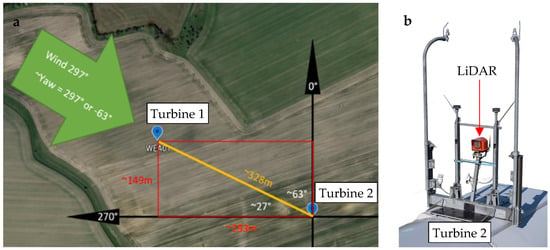
Figure 1.
Experimental setup. (a) Wind farm layout; (b) nacelle-mounted LiDAR on Turbine 2.
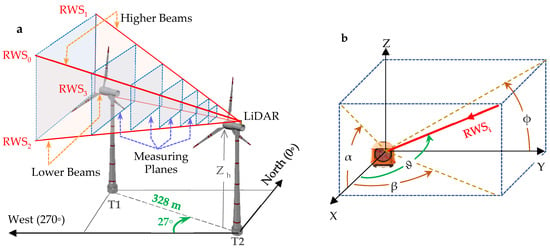
Figure 2.
(a) Measuring locations, beams, and planes of the LiDAR in aligned turbines; (b) LiDAR coordinate and parameters. The LeoSphere LiDAR sensor computes 10 min of average data every 10 min for two years (from 2020 to 2022).
The measuring LiDAR sensor (Figure 2b) maintains constant α and β angles of 5 and 15 degrees, respectively. As a result, the angles ϑ and φ can be directly calculated based on these fixed values.
The methodology employed to acquire and assess the LiDAR measurements and evaluate the interaction model is discussed in Section 2.5. It describes the process of estimating the ‘Direction to Hub’ parameter from LiDAR measurements and subsequently comparing it with the basic predictions.
2.2. Two-Dimensional Gaussian Jensen Wake Model
In employing the basic Jensen wake model to predict the velocity deficit in the turbine wake, it is assumed that the wake expands radially in a circular pattern, with the wake centerline as the axis of symmetry. The velocity deficit within the wake is then represented as a Gaussian distribution of mass, where the highest velocity deficit at the wake’s centerline gradually decreases as the distance from the centerline increases [4,7]. This mass distribution is described by Equation (1), which accounts for the wake velocity deficit, the distance from the wake centerline, and the turbulence intensity of the ambient flow and is used here.
where is the inflow wind velocity, is the wake velocity, is the downwind distance from the wind turbine, r is the radial distance from the rotor axis, R is the rotor radius, is the thrust coefficient, and k′ is the wake expansion rate [45] given in Equation (2), where is the reference turbulence intensity.
2.3. Cylindrical Vortex Induction Model
Recently, Keane et al. [46] proposed an analytical method for the wind in the induction zone. Note that the axial velocity decreases from its upwind value to the rotor plane [47]. The axial velocity downwind of the rotor may be expressed as , where a is the axial induction factor, calculated from Equation (3) [48].
The largest velocity deficit occurs at the largest local thrust coefficient () [49]. Accordingly, the cylindrical vortex induction zone model by Branlard et al. [44] estimates axial wind velocity in non-yaw actuator disk simulation based on Equations (4) and (5).
where x is the upwind distance from the downwind rotor [43], and and ∏ are the complete first and third kinds of elliptical integrals [42].
2.4. A Simple Interaction Model
An integration method is proposed to establish a wake–induction interaction model for two partially aligned wind turbines under different wind flow directions. The model considers the effect of varying wind directions, as illustrated in Figure 3.
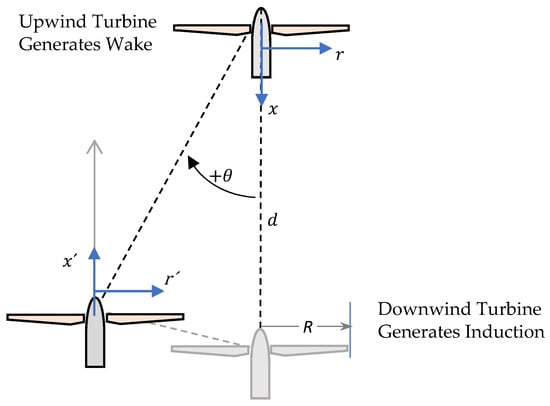
Figure 3.
Basic parameters in partially aligned wind turbines.
To integrate the wake and induction models, their respective coordinates must align. Figure 3 illustrates the axial distance () and radial distance (r) from the upwind rotor’s plane and axis, which are used in the wake model. Similarly, the axial distance (x′) and radial distance (r′) from the downwind rotor’s plane and axis, which are employed in the induction model (Equations (5) and (6)), are also shown. A conversion can be applied to establish a correspondence between the two coordinate systems, allowing the transformation of one set of coordinates to the other as
The distance between the two wind turbines is denoted as ‘d’, and the wind inflow angle () represents the direction of the wind flow in relation to the line connecting the two towers. In this scenario, two synchronized variations of axial velocities occur between the turbines: the wind velocity from the wake (as described in Equation (1)) and the wind velocity from the induction (as described in Equation (4)). The interaction model incorporates the normalized fraction of the wake’s axial velocity in the induction, as illustrated in Equation (8). For the sake of simplicity, it is assumed that any change in the thrust coefficient at the downwind rotor plane caused by the upwind wake is negligible.
2.5. Evaluation Methodology
As outlined in Section 2.1, the test is conducted to measure wind characteristics utilizing a nacelle-mounted LiDAR system installed on a wind turbine. Based on these measurements, a simple model is set to predict the wind characteristics, as detailed in Section 2.2 and Section 2.3, and the interaction model in Section 2.4. However, to assess the model’s accuracy, it is essential to consider the potential impact of installation errors and other factors that could influence the measurements. Hence, in this section, we introduce the ‘Direction to Hub’ parameter and describe the method used to estimate it from the LiDAR measurements. This parameter incorporates the ‘shift angle’ parameter, which denotes the angular error on the horizontal plane during LiDAR installation, as depicted in Figure 4a. Despite adhering to stringent installation guidelines, errors may occur due to structural deformations, calibration loss, and installation base issues, potentially leading to measurement inaccuracies. To account for this, axial wind velocities for the LiDAR’s right () and left () beams are calculated using Equation (9).
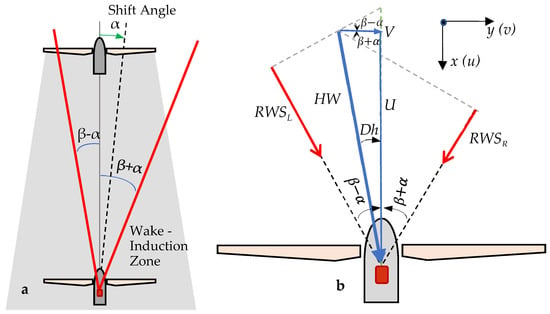
Figure 4.
(a) Shift angle installation error, and (b) estimation of Direction to Hub in the nacelle-based LiDAR.
The radial (r) and axial distances (x) of the measuring points on the left and right LiDAR beams are calculated as follows:
where y is the axial distance of the measuring planes from the LiDAR head. The measurement planes are positioned at seven specific distances (50, 75, 100, 150, 200, 250, and 300 m) in front of the LiDAR system. Within these planes, the LiDAR beams capture the radial component of the wind speed at its four corners (as shown in Figure 4b).
The axial and tangential wind velocity components in Equations (11) and (12) are obtained from the projection of the radial wind velocity measured by LiDAR along the directions.
The wind direction relative to the rotor axis at the hub height, referred to as Direction to Hub (), can be determined using the axial and tangential wind velocity components. Equation (13) provides the , considering the correction for the negative impact of the shift angle in the formulation.
3. Results and Discussion
Figure 5a displays the power production of wind turbines on the examined wind farm, revealing that the turbines have a rated power of 3.3 MW and a rated wind speed of approximately 10 m/s. Due to the relative proximity of the turbines, with a distance less than commonly recommended, the wake effects are considerably pronounced along the aligned direction. When the wind blows from around 297 or 117 degrees north, one turbine experiences reduced production due to the wake effect generated by the other turbine. This effect is clearly illustrated in Figure 5b, where the wake generated by the upwind turbine (T2) interacts with the rotor of the downwind turbine (T1), resulting in power loss in the downstream turbine along the aligned direction (117 degrees in Figure 5b).
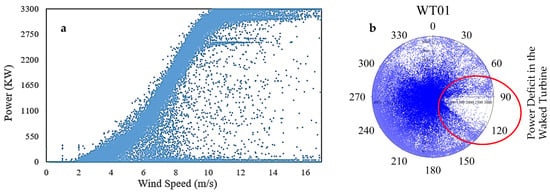
Figure 5.
Power production: (a) power—wind speed curve of turbine No. 1, and (b) angular distribution of the power production of turbine No. 1 exhibiting a power deficit around the wind inflow angle of 117 degrees north.
Figure 6 illustrates the flow’s contours; the velocity deficit generated by the upwind turbine is depicted in Figure 6a. This velocity deficit is further affected due to the induction of the downwind turbine (Figure 6b). As a result of this interaction, the flow is distributed between the two turbines, as shown in Figure 6c.
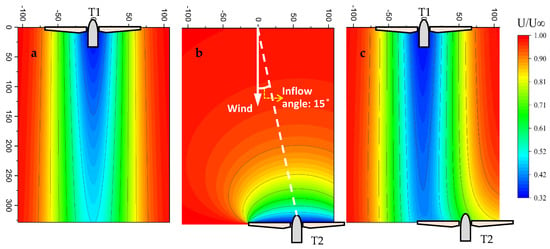
Figure 6.
(a) Wake model, (b) induction model, and (c) the wake–induction interaction model, shown for the inflow angle of 15 degrees.
The wake–induction interaction model, encompassing a wide range of inflow angles and accounting for all potential partial wakes, is subsequently applied to evaluate the two-utility-scale wind turbine array. Figure 7 displays contours illustrating the turbine interactions observed from a top view of the LiDAR laser beams. Figure 7a depicts the impact of downwind induction from the aligned turbine, while Figure 7b,c represent scenarios involving different inflow directions.
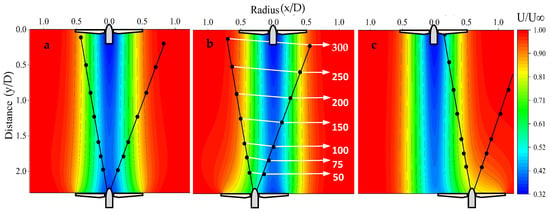
Figure 7.
Contours: wake and induction interaction model between the turbines at the inflow angle : (a) 0 degrees, (b) −7 degrees, and (c) 15 degrees, all with the shift angle α = 4.4°. Black dots are LiDAR locations at the measuring planes with an indicated axial distance from the downstream turbine (in meters).
The LiDAR data obtained from various overlapping angles of the two turbines can be compared with the model to assess their agreement. In Figure 7, the black lines represent the LiDAR beams, and the black dots represent the measurement points on the measuring planes (Figure 7b). The parameter d/D = 2.3 corresponds to the tower-to-tower distance on the wind farm.
Figure 8 shows a comparison between the model and the measured data. The calculated Dh using Equation (13) exhibits a similar trend to the measured data. However, a shift angle is observed in the measurements, referred to as zero-up shift, which is approximately 4.5 degrees in this case (Figure 8a). Since this parameter is included in the model formulation, it is also reflected in the model’s output data (Figure 8b). It is important to note that the model diagram should be symmetrical without any shift angle, which can help identify installation errors. Additionally, the asymmetrical distribution of Dh calculated from the measurements on both sides of the tower-to-tower connecting line may be attributed to the rotation direction of the rotor.
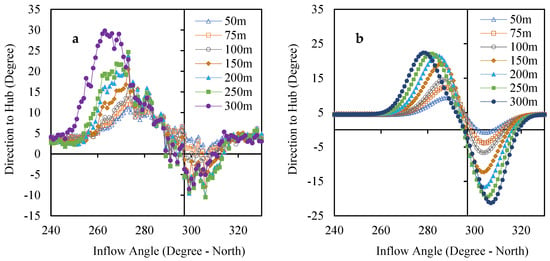
Figure 8.
Direction to Hub. (a) LiDAR and (b) model.
A direct comparison of the Direction to Hub (Dh) is shown in Figure 9, indicating that the measurement data asymmetry is more pronounced than the calculations. Despite correcting the shift angle, the model exhibits more symmetric features. However, there is a noticeable discrepancy, particularly on the left side of the inflow angle. The model’s prediction of the location of the Dh peaks is not accurately estimated, with an average difference of approximately 15 degrees towards the center line. This error is attributed to the simplicity of the wake model, as it is a single-hat Gaussian-shaped wake model and does not include the effect of the nacelle in the near wake, which leads to significant differences between the proposed model and the actual data, especially in the near wake regions (greater distances from the down turbine). Another potential factor contributing to this error is the omission of an accurate wake expansion.
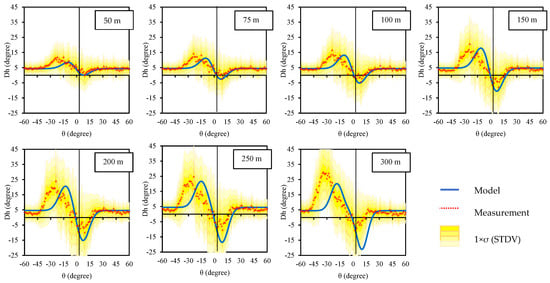
Figure 9.
Comparison of Direction to Hub (Dh) at various locations (from Figure 5).
The asymmetric feature in the wake region can be attributed to the rotation direction of the turbine blades, which is not taken into account in the proposed model. It combines the Gaussian-distributed Jensen wake model and a cylindrical vortex induction model and is designed to provide a fast and cost-effective analytical approach for approximating flow interactions in the turbine array. However, the simplicity of this model does not capture the specific effects of turbine blade rotation, which may contribute to the observed asymmetry in the wake region.
Figure 8 and Figure 9 highlight the discrepancy between the model and the measurements in the maximum value of the Dh peaks. The difference in peak values can be attributed to the weaker influence of induction compared to the wake effect, as both effects are symmetric with respect to the downstream turbine. As the shift angle increases, the induction effect becomes more pronounced. The difference in peaks between the model and the measurements diminishes as the distance from the upwind turbine increases, particularly noticeably on the left side of the inflow angle.
As discussed, most outliers were observed in the left-half region of the inflow angle. To improve the accuracy and reduce these outliers, further research is needed. This could involve developing more advanced wake and induction models, considering more accurate wake expansion effects, and incorporating correction functions such as double-head Gaussian functions in the interaction formulation.
4. Conclusions
This study presents a simple wake–induction interaction model evaluated using field data obtained from a utility-scale wind turbine system equipped with a nacelle-mounted four-beam LiDAR. The model provided reasonable estimating of the wake–induction interaction between the two turbines using the Direction to Hub (Dh) parameter. However, the actual wake profile exhibited asymmetry within the limited range of the angles covered by the experimental data, which was not fully captured by the proposed model with a maximum Dh angle of 245 degrees (Figure 8). Despite this limitation, Dh proved to be a sensitive parameter for evaluating theoretical models and could also be used for horizontal position calibrations of nacelle-mounted LiDARs. To improve the model, it is recommended to consider wake expansion correction and explore alternative wake or induction formulations to enhance the accuracy of peak value estimations for Dh. Also, implementing correction functions can help mitigate prediction outliers in the wake–induction interaction model, thus improving its applicability for wind farm flow simulation and control. To sum up, this study presents a basic methodology for measuring and predicting wind characteristics using LiDAR measurements. By developing and validating a simple model based on these measurements, we showcased the potential to enhance the efficiency of wind turbine arrays. The precise estimations of wind characteristics hold significant importance for optimizing wind turbine operations and reducing the cost of wind energy production.
Author Contributions
Conceptualization, E.M., M.K., U.R., A.E. and L.P.C.; Methodology, E.M.; Validation, A.E. and U.R.; Formal analysis, M.K.; Investigation, E.M.; Resources, A.E. and U.R.; Data curation, M.K.; Writing—original draft, E.M.; Writing—review & editing, E.M., M.K., L.P.C. and A.K.; Visualization, M.K.; Supervision, E.M.; Funding acquisition, U.R. All authors have read and agreed to the published version of the manuscript.
Funding
The researcher of this project was finantially supported by the University of Rostock and the Shahrood University of Technology, independently.
Data Availability Statement
The data presented in this study are restricted but may be available by agreement between parties. Please contact the corresponding author.
Acknowledgments
We want to thank the Wind Energy Technology Institute, University of Rostock, the Wind-Projekt Company as the owner of the LiDAR system for providing the experimental data for this project, the Siemens Gamesa Company for their consultants, Center for International Scientific Studies and Collaborations (CISSC) of Iran for their support, and M.Kamandi for the valuable discussions.
Conflicts of Interest
The authors declare no conflict of interest.
References
- Thresher, R.; Robinsion, M.; Veers, P. Wind Energy Technology: Current Status and R&D Future; National Renewable Energy Lab. (NREL): Golden, CO, USA, 2008. [Google Scholar]
- Barthelmie, R.J.; Rathmann, O.; Frandsen, S.T.; Hansen, K.S.; Politis, E.; Prospathopoulos, J.; Rados, K.; Cabezón, D.; Schlez, W.; Phillips, J. Modelling and measurements of wakes in large wind farms. J. Phys. Conf. Ser. 2007, 78, 12049. [Google Scholar] [CrossRef]
- Jensen, N.O. A Note on Wind Generator Interaction; Risø National Laboratory Citeseer: Roskilde, Denmark, 1983; Volume 2411. [Google Scholar]
- Bastankhah, M.; Porté-Agel, F. A new analytical model for wind-turbine wakes. Renew. Energy 2014, 75, 116–123. [Google Scholar] [CrossRef]
- Bastankhah, M.; Porté-Agel, F. Experimental and theoretical study of wind turbine wakes in yawed conditions. J. Fluid Mech. 2016, 806, 506–541. [Google Scholar] [CrossRef]
- Shapiro, C.R.; Gayme, D.F.; Meneveau, C. Modelling yawed wind turbine wakes: A lifting line approach. J. Fluid Mech. 2018, 841, R1. [Google Scholar] [CrossRef]
- Gao, X.; Yang, H.; Lu, L. Optimization of wind turbine layout position in a wind farm using a newly-developed two-dimensional wake model. Appl. Energy 2016, 174, 192–200. [Google Scholar] [CrossRef]
- Qian, G.-W.; Ishihara, T. A New Analytical Wake Model for Yawed Wind Turbines. Energies 2018, 11, 665. [Google Scholar] [CrossRef]
- Larsen, G.C.; Madsen, H.A.; Bingöl, F.; Mann, J.; Ott, S.; Sørensen, J.N.; Okulov, V.; Troldborg, N.; Nielsen, M.; Thomsen, K.; et al. Dynamic Wake Meandering Modeling; Risø-R-1607; Risø National Laboratory: Roskilde, Denmark, 2007. [Google Scholar]
- Blondel, F.; Cathelain, M. An alternative form of the super-Gaussian wind turbine wake model. Wind Energy Sci. 2020, 5, 1225–1236. [Google Scholar] [CrossRef]
- Shapiro, C.R.; Starke, G.M.; Meneveau, C.; Gayme, D.F. A wake modeling paradigm for wind farm design and control. Energies 2019, 12, 2956. [Google Scholar] [CrossRef]
- Martínez-Tossas, L.A.; King, J.; Quon, E.; Bay, C.J.; Mudafort, R.; Hamilton, N.; Howland, M.F.; Fleming, P.A. The curled wake model: A three-dimensional and extremely fast steady-state wake solver for wind plant flows. Wind Energy Sci. 2021, 6, 555–570. [Google Scholar] [CrossRef]
- Bastankhah, M.; Shapiro, C.R.; Shamsoddin, S.; Gayme, D.F.; Meneveau, C. A vortex sheet based analytical model of the curled wake behind yawed wind turbines. J. Fluid Mech. 2022, 933, A2. [Google Scholar] [CrossRef]
- Mohammadi, M.; Bastankhah, M.; Fleming, P.; Churchfield, M.; Bossanyi, E.; Landberg, L.; Ruisi, R. Curled-Skewed Wakes behind Yawed Wind Turbines Subject to Veered Inflow. Energies 2022, 15, 9135. [Google Scholar] [CrossRef]
- Abkar, M.; Sørensen, J.N.; Porté-Agel, F. An analytical model for the effect of vertical wind veer on wind turbine wakes. Energies 2018, 11, 1838. [Google Scholar] [CrossRef]
- Sorensen, J.N.; Shen, W.Z. Numerical modeling of wind turbine wakes. J. Fluids Eng. 2002, 124, 393–399. [Google Scholar] [CrossRef]
- Mahmoodi, E.; Schaffarczyk, A.P. Actuator disc modeling of the MEXICO rotor experiment. In Wind Energy-Impact of Turbulence; Springer: Berlin/Heidelberg, Germany, 2014; pp. 29–34. [Google Scholar]
- Stein, V.P.; Kaltenbach, H.-J. Validation of a Large-Eddy Simulation Approach for Prediction of the Ground Roughness Influence on Wind Turbine Wakes. Energies 2022, 15, 2579. [Google Scholar] [CrossRef]
- Howland, M.F.; Quesada, J.B.; Martínez, J.J.P.; Larrañaga, F.P.; Yadav, N.; Chawla, J.S.; Sivaram, V.; Dabiri, J.O. Collective wind farm operation based on a predictive model increases utility-scale energy production. Nat. Energy 2022, 7, 818–827. [Google Scholar] [CrossRef]
- Forsting, A.R.M. Modelling Wind Turbine Inflow: The Induction Zone; DTU Wind Energy: Lyngby, Denmark, 2017. [Google Scholar] [CrossRef]
- Kidambi Sekar, A.P.; van Dooren, M.F.; Rott, A.; Kühn, M. Lower Order Description and Reconstruction of Sparse Scanning Lidar Measurements of Wind Turbine Inflow Using Proper Orthogonal Decomposition. Remote Sens. 2022, 14, 2681. [Google Scholar] [CrossRef]
- Conti, D.; Dimitrov, N.; Peña, A. Aeroelastic load validation in wake conditions using nacelle-mounted lidar measurements. Wind Energy Sci. 2020, 5, 1129–1154. [Google Scholar] [CrossRef]
- Borraccino, A.; Schlipf, D.; Haizmann, F.; Wagner, R. Wind field reconstruction from nacelle-mounted lidar short-range measurements. Wind Energy Sci. 2017, 2, 269–283. [Google Scholar] [CrossRef]
- Wagner, R.; Pedersen, T.F.; Courtney, M.; Antoniou, I.; Davoust, S.; Rivera, R.L. Power curve measurement with a nacelle mounted lidar. Wind Energy 2014, 17, 1441–1453. [Google Scholar] [CrossRef]
- Dimitrov, N.; Borraccino, A.; Peña, A.; Natarajan, A.; Mann, J. Wind turbine load validation using lidar-based wind retrievals. Wind Energy 2019, 22, 1512–1533. [Google Scholar] [CrossRef]
- Conti, D.; Dimitrov, N.; Peña, A.; Herges, T. Probabilistic estimation of the Dynamic Wake Meandering model parameters using SpinnerLidar-derived wake characteristics. Wind Energ. Sci. 2021, 6, 1117–1142. [Google Scholar] [CrossRef]
- Angelou, N.; Sjöholm, M. Data Reliability Enhancement for Wind-Turbine-Mounted Lidars. Remote Sens. 2022, 14, 3225. [Google Scholar] [CrossRef]
- Scholbrock, A.; Fleming, P.; Fingersh, L.; Wright, A.; Schlipf, D.; Haizmann, F.; Belen, F. Field Testing LIDAR-Based Feed-Forward Controls on the NREL Controls Advanced Research Turbine. Aerospace Sciences Meeting Including the New Horizons Forum and Aerospace Exposition; ARC: Grapevine, TX, USA, 2013; p. 818. [Google Scholar]
- Giyanani, A.; Bierbooms, W.; van Bussel, G.J.W. Estimation of rotor effective wind speeds using autoregressive models on Lidar data. J. Phys. Conf. Ser. 2016, 753, 072018. [Google Scholar] [CrossRef]
- Fleming, P.; Annoni, J.; Scholbrock, A.; Quon, E.; Dana, S.; Schreck, S.; Raach, S.; Haizmann, F.; Schlipf, D. Full-scale field test of wake steering. J. Phys. Conf. Ser. 2017, 854, 012013. [Google Scholar] [CrossRef]
- Adcock, C.; King, R.N. Data-driven wind farm optimization incorporating effects of turbulence intensity. In Proceedings of the 2018 Annual American Control Conference (ACC), Milwaukee, WI, USA, 27–29 June 2018; pp. 695–700. [Google Scholar]
- Giyanani, A.; Savenije, F.J.; Van Bussel, G.J.W. Correlation between Lidar measured wind speeds and aerodynamic loading. J. Phys. Conf. Ser. 2018, 1037, 052038. [Google Scholar] [CrossRef]
- Qu, C.; Lin, Z.; Han, X.; Wang, C.; Wu, Q.; Li, X.; Zhang, Z.; Gong, Y.; Jiang, G. Improved Data-Driven Yaw Misalignment Calibration of Wind Turbine via LiDAR Verification. In Proceedings of the Chinese Automation Congress 2020, Shanghai, China, 6–8 November 2020; pp. 5611–5616. [Google Scholar]
- Chen, Y.; Guo, F.; Schlipf, D.; Cheng, P.W. 4d wind field generation for the aeroelastic simulation of wind turbines with lidars. Wind Energy Sci. Discuss. 2021, 2021, 539–558. [Google Scholar]
- Rinker, J.M. Impact of rotor size on aeroelastic uncertainty with lidar-constrained turbulence. J. Phys. Conf. Ser. 2022, 2265, 032011. [Google Scholar] [CrossRef]
- Couto, A.; Justino, P.; Simões, T.; Estanqueiro, A. Impact of the wave/wind induced oscillations on the power performance of the WindFloat wind turbine. J. Phys. Conf. Ser. 2022, 2362, 012010. [Google Scholar] [CrossRef]
- Russell, A.J.; Collu, M.; McDonald, A.; Thies, P.R.; Mortimer, A.; Quayle, A.R. Review of LIDAR-assisted control for offshore wind turbine applications. J. Phys. Conf. Ser. 2022, 2362, 012035. [Google Scholar] [CrossRef]
- Iungo, G.V.; Wu, Y.-T.; Porté-Agel, F. Field measurements of wind turbine wakes with lidars. J. Atmos. Ocean. Technol. 2013, 30, 274–287. [Google Scholar] [CrossRef]
- Lundquist, J.K.; Churchfield, M.J.; Lee, S.; Clifton, A. Quantifying error of lidar and sodar Doppler beam swinging measurements of wind turbine wakes using computational fluid dynamics. Atmos. Meas. Tech. 2015, 8, 907–920. [Google Scholar] [CrossRef]
- Klaas, T.; Emeis, S. The five main influencing factors on lidar errors in complex terrain. Wind. Energy Sci. Discuss. 2021, preprint. [Google Scholar] [CrossRef]
- Li, X.; Qiu, Y.; Feng, Y.; Wang, Z. Wind turbine power prediction considering wake effects with dual laser beam LiDAR measured yaw misalignment. Appl. Energy 2021, 299, 117308. [Google Scholar] [CrossRef]
- Forsting, A.M.; Rathmann, O.S.; Laan, M.P.v.d.; Troldborg, N.; Gribben, B.; Hawkes, G.; Branlard, E. Verification of induction zone models for wind farm annual energy production estimation. J. Phys. Conf. Ser. 2021, 1934, 12023. [Google Scholar] [CrossRef]
- Branlard, E.; Gaunaa, M. Cylindrical vortex wake model: Right cylinder. Wind Energy 2015, 18, 1973–1987. [Google Scholar] [CrossRef]
- Branlard, E.S.P.; Forsting, A.R.M. Using a cylindrical vortex model to assess the induction zone infront of aligned and yawed rotors. In Proceedings of the EWEA Offshore 2015 Conference, Copenhagen, Denmark, 10–12 March 2015. [Google Scholar]
- Brugger, P.; Fuertes, F.C.; Vahidzadeh, M.; Markfort, C.D.; Porté-Agel, F. Characterization of Wind Turbine Wakes with Nacelle-Mounted Doppler LiDARs and Model Validation in the Presence of Wind Veer. Remote Sens. 2019, 11, 2247. [Google Scholar] [CrossRef]
- Keane, A.; Nisbet, I.; Calvo, G.; Pickering, G.; Tulloch, J.; More, G.; Koronka, N. Wind farm cumulative induction zone effect and the impact on energy yield estimation. Renew. Energy 2022, 181, 1209–1222. [Google Scholar] [CrossRef]
- Khanjari, A.; Mahmoodi, E.; Ahmadi, M.H. Energy and exergy analyzing of a wind turbine in free stream and wind tunnel in CFD domain based on actuator disc technique. Renew. Energy 2020, 160, 231–249. [Google Scholar] [CrossRef]
- Segalini, A. An analytical model of wind-farm blockage. J. Renew. Sustain. Energy 2021, 13, 33307. [Google Scholar] [CrossRef]
- Troldborg, N.; Meyer Forsting, A.R. A simple model of the wind turbine induction zone derived from numerical simulations. Wind Energy 2017, 20, 2011–2020. [Google Scholar] [CrossRef]
Disclaimer/Publisher’s Note: The statements, opinions and data contained in all publications are solely those of the individual author(s) and contributor(s) and not of MDPI and/or the editor(s). MDPI and/or the editor(s) disclaim responsibility for any injury to people or property resulting from any ideas, methods, instructions or products referred to in the content. |
© 2023 by the authors. Licensee MDPI, Basel, Switzerland. This article is an open access article distributed under the terms and conditions of the Creative Commons Attribution (CC BY) license (https://creativecommons.org/licenses/by/4.0/).